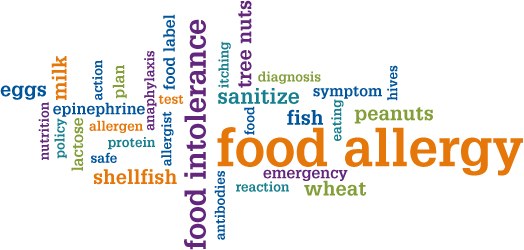Food allergies in children have increased significantly in recent years though the reason why is not yet clearly known. Understanding how to manage food allergies in the child care setting is essential for keeping children safe and for helping parents to feel confident about the ability of other caregivers to know what to do, especially in the event of a food allergy emergency.

Currently there is no cure for food allergies, which can vary in degree of severity. Some children with known food allergies may experience a mild reaction such as itchiness, swelling or hives. Other reactions may be more severe resulting in difficulty breathing, nausea and vomiting and even anaphylaxis, which can be fatal if not treated immediately. Children can also experience a food allergy reaction for the first time while in the child care setting so it is important for child care staff to be aware of common symptoms.
What is a food allergy?
A food allergy occurs when the body reacts to a specific protein in a food. As a result, the body's immune system releases antibodies, most commonly IgE antibodies, which cause an allergic reaction. The most common foods containing allergens are eggs, wheat, milk, peanuts, tree nuts, soy, fish and shellfish. Ninety percent of food allergy reactions are associated with these foods.
When a food allergy is suspected, the child should be seen by an allergist (a physician specializing in allergies) to determine an accurate diagnosis. Once the diagnosis has been made, the allergist and the family develop a Food Allergy Action Plan (FAAP) that specifies the foods to be avoided and instructs caregivers what to do if the child is exposed to the allergen.
Although mild food allergies are typically treated with an antihistamine (such as Benadryl®), more severe reactions may require epinephrine injections. Children with severe food allergies should have an epinephrine auto-injector such as an EpiPen® that travels with them at all times in case of a food allergy emergency. Child care staff should be trained on the use of epinephrine since prompt administration is essential if a child with a food allergy accidentally ingests a food containing the allergen, and develops a severe allergic reaction.
If a food allergy emergency occurs, the caregiver should administer the epinephrine and then call 911 so that the child can receive further treatment. Parents should be notified and the incident recorded. Although food allergy emergencies are rare, if proper precautions are taken, acting promptly can save a child's life.
Young children may not be able to clearly express that they are experiencing an allergic reaction. Some of the things a child might say that could indicate this are:
- It feels like something is poking my tongue.
- My mouth (or tongue) itches.
- My lips feel tight.
- It feels like there is a frog or something in my throat.
- It feels like there are bugs in my ears.
Source: The Food Allergy and Anaphylaxis Network
Managing food allergies in child care
Determining how best to manage food allergies in the child care setting depends on the type and severity of the allergy. Some programs may choose to go "nut-free" to reduce the risk of exposure. Others may have children with food allergies seated together at a table or have a "nut-free" table. Food labels need to be checked for allergens, and food service staff needs to be aware of any allergies and provide alternatives for children who need them.
Special care needs to be taken regarding food sent from home to make sure it is allergen free. If there is any doubt, the food should not be served to the child with food allergies. For this reason, it is a good idea to have some "safe snacks" on hand that can be served as an alternative.
Food prep surfaces and utensils must be carefully cleaned and sanitized to ensure that any potential allergens have been removed. Likewise, children need to wash hands before and after meals and snacks to reduce the risk of cross-contamination.
Proper training, clear communication with families and having a plan in place is important for managing food allergies in the child care setting. For more information, go to the Better Kid Care On Demand learning system and complete the lesson Food Allergies: Management and Prevention.

